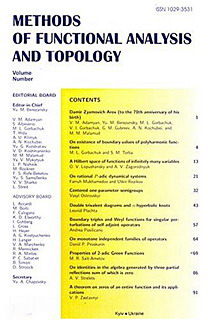Vol. 20 (2014), no. 1
Volodymyr Dmytrovych Koshmanenko (to his 70th birthday)
MFAT 20 (2014), no. 1, 1-2
1-2
On large coupling convergence within trace ideals
MFAT 20 (2014), no. 1, 3-9
3-9
Let $\mathcal E$ and $\mathcal P$ be nonnegative quadratic forms such that $\mathcal E + b \mathcal P$ is closed and densely defined for every nonnegative real number $b$. Let $H_b$ be the selfadjoint operator associated with $\mathcal E + b\mathcal P.$ By Kato's monotone convergence theorem, there exists an operator $L$ such that $(H_b+1)^{-1}$ converges to $L$ strongly, as $b$ tends to infinity. We give a condition which is sufficient in order that the operators $(H_b+1)^{-1}$ converge w.r.t. the trace norm with convergence rate $O(1/b)$. As an application we discuss trace norm resolvent convergence of Schrodinger operators with point interactions.
On the discrete spectrum of a linear operator pencil arising in transport theory
MFAT 20 (2014), no. 1, 10-16
10-16
We study the problem of the finiteness of the discrete spectrum for linear operator pencils occurring in one-velocity transport theory. The results are obtained using direct methods of perturbation theory for linear operators. The proposed approach allowed to give a relatively quick proofs of the main results improving related results obtained previously by K. M. Case and C. G. Lekkerkerker.
Delta-type solutions for a system of induction equations with discontinuous velocity field
A. I. Esina, A. I. Shafarevich
MFAT 20 (2014), no. 1, 17-33
17-33
We study asymptotic solutions of a Cauchy problem for induction equations describing magnetic field in a well conducting fluid. We assume that the coefficient (the velocity field of the fluid) changes rapidly in a small vicinity of a two-dimensional surface. We prove that the weak limit of the solution has delta-type singularity on this surface; in the case of a perfectly conducting fluid, we describe several regularizations of the problem with discontinuous coefficients which allow to define generalized solutions.
Schrödinger operators with non-symmetric zero-range potentials
MFAT 20 (2014), no. 1, 34-49
34-49
Non-self-adjoint Schrödinger operators $A_{\mathbf{T}}$ which correspond to non-symmetric zero-range potentials are investigated. For a given $A_{\mathbf{T}}$, a description of non-real eigenvalues, spectral singularities and exceptional points are obtained; the possibility of interpretation of $A_{\mathbf{T}}$ as a self-adjoint operator in a Krein space is studied, the problem of similarity of $A_{\mathbf{T}}$ to a self-adjoint operator in a Hilbert space is solved.
On a criterion of mutual adjointness for extensions of some nondensely defined operators
MFAT 20 (2014), no. 1, 50-58
50-58
In the paper the role of initial object is played by a pair of closed linear densely defined operators $L_0$ and $M_0$, where $L_0 \subset M_0^{\ast}:= L,$ acting in Hilbert space. A criterion of mutual adjointness for some classes of the extensions of finite-dimensional (non densely defined) restrictions of $L_0$ and $M_0$ are established. The main results are based on the theory of linear relations in Hilbert spaces and are formulated in the terms of abstract boundary operators.
On the common point spectrum of pairs of self-adjoint extensions
MFAT 20 (2014), no. 1, 59-67
59-67
Given two different self-adjoint extensions of the same symmetric operator, we analyse the intersection of their point spectra. Some simple examples are provided.
Eigenfunction expansions associated with an operator differential equation non-linearly depending on a spectral parameter
MFAT 20 (2014), no. 1, 68-91
68-91
For an operator differential equation that depends on a spectral parameter in the Nevanlinna manner we obtain expansions in eigenfunctions.
Continuous dual of $c_0(Z,X,\bar\lambda, \bar p)$ and $c(Z,X,\bar\lambda, \bar p)$
Riti Agrawal, J. K. Srivastava
MFAT 20 (2014), no. 1, 92-100
92-100
A bilateral sequence is a function whose domain is the set $Z$ of all integers with natural ordering. In this paper we study the continuous dual of the Banach space of $X$-valued bilateral sequence spaces $c_0(Z,X,\bar\lambda, \bar p)$ and $c(Z,X,\bar\lambda, \bar p)$.


